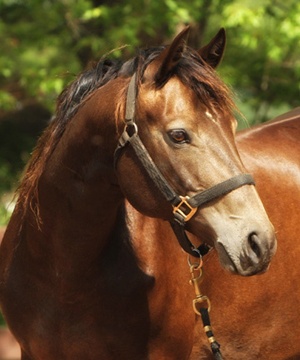General Description
Appendix Horse: - A horse registered with AQHA which is the result of breeding a Thoroughbred and an American Quarter Horse that has a permanent number, or a combination of an Appendix numbered American Quarter Horse and an American Quarter Horse with a permanent number. Appendix horses are distinguished by an "X" in front of their registration number and their certificates are gold.
There are three different mixes of horses that are eligible to be registered in AQHA's registry:
1. Registered Appendix (X) + Registered American Quarter Horse (QH) ' Registered Appendix foal(X)
2. Registered American Quarter Horse (QH) + Registered American Quarter Horse (QH) ' Registered American Quarter Horse foal (QH)
3. Recognized Thoroughbred (TB) + Registered American Quarter Horse (QH) ' Registered Appendix foal (X)
Colors of Horses
There are 13 recognized colors for American Quarter Horses. Bay, Black, Brown, Sorrel, Chestnut, Dun, Buckskin, Red Dun, Grullo, Palomino, Gray, Red Roan, Blue Roan.
Bay: Body color ranging from tan, through red, to reddish brown; mane and tail black; usually black on lower legs.
Black: Body color true black without light areas; mane and tail black.
Brown: Body color brown or black with light areas at muzzle, eyes, flank, and inside upper legs; mane and tail black.
Sorrel: Body color reddish or copper-red; mane and tail usually same color as body, but may be flaxen. The most common color of American Quarter Horses.
Chestnut: Body color dark red or brownish-red; mane and tail usually dark red or brownish-red but may be flaxen.
Dun: Body color yellowish or gold; mane and tail may be black, brown, red, yellow, white or mixed; often has dorsal stripe, zebra stripes on legs, transverse over withers.
Buckskin: Body color yellowish or gold; mane and tail black; usually black on lower legs.
Red Dun: A form of dun with body color yellowish or flesh colored; mane, tail and dorsal stripe are red.
Grullo: Body color smoky or mouse-colored (not a mixture of black and white hairs, but each hair mouse-colored.) ; mane and tail black; usually black on the lower legs; often has dorsal stripe.
Palomino: Body color golden yellow, mane and tail white. Palominos typically do not have dorsal stripes.
Gray: Body color a mixture of white with any other colored hairs; often born solid-colored or almost solid-colored and gets lighter with age as more white hairs appear.
Red Roan: More or less uniform mixture of white with red hairs on the body, but usually darker on head and lower legs; can have red, black, or flaxen mane and/or tail.
Blue Roan: More or less a uniform mixture of white with black hairs on the body, but usually darker on head and lower legs; can have a few red hairs in mixture.
AAHA allows the horse breeder to take the Thoroughbred horse, the Quarter Horse or Paint and make the Appendix breed. Breeding Stock Paints are welcome to dual register without any prejudice to lack of color, or the Paint with Thoroughbred in their bloodline may dual register without prejudice to having color. The coded appendix horse in the American Quarter Horse Association is welcome to register in as the Appendix breed of horse. Allowing the owner to breed this horse to other horses and keep the pedigree ongoing.
AAHA has an Enrollment program for horse owners of Quarter Horse, Paints and Thoroughbred to enroll their horse's pedigree in AAHA, so that the offspring of these horses are eligible for Registration into AAHA as an Appendix breed. If you have a stallion this will give you more revenue because you can offer mare owners breeding certificate to register in AAHA. You may breed your Quarter Horse to a Paint, Thoroughbred or another Appendix or coded appendix with AQHA and offer the owner a way to register the foal. A Paint or Thoroughbred stallion owner may also do the same thing.






